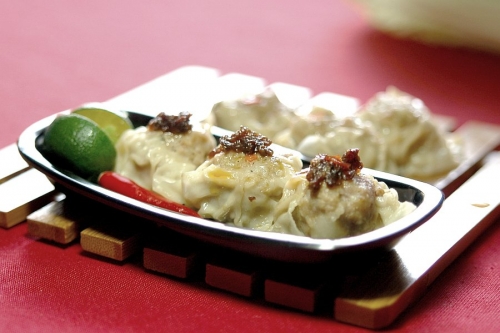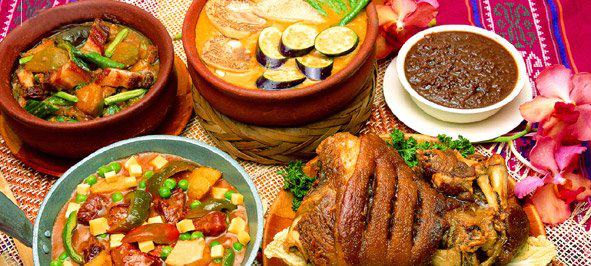|
Pancit Molo
Pancit Molo (also Molo Soup or Molo Balls Soup) or Filipino pork dumpling soup, is a type of soup made using wonton wrappers which originated from Molo district in Iloilo City, Philippines. It consists of a mixture of ground pork wrapped in molo or wonton wrapper, shredded chicken meat, and also shrimp. The piping-hot soup is often ladled into serving bowls, and garnished with green onions and fried garlic bits for another layer of flavor. Pancit, which loosely translates to "noodle" is a common cuisine in the Philippines. The "noodle" acting in this dish comes from the wonton wrappers added to this dish, which draws from Chinese cuisine. Under this influence, the wontons within the soup have been compared to " siomai dumplings." Popularity Pancit Molo is a popular dish and street food in the region Molo, Iloilo. Iloilo, sometimes called the "food haven of the Philippines" is renowned for this soup, as well as another called La Paz Batchoy. One travel guide has dubbed the ... [...More Info...] [...Related Items...] OR: [Wikipedia] [Google] [Baidu] |
Philippines
The Philippines, officially the Republic of the Philippines, is an Archipelagic state, archipelagic country in Southeast Asia. Located in the western Pacific Ocean, it consists of List of islands of the Philippines, 7,641 islands, with a total area of roughly 300,000 square kilometers, which are broadly categorized in Island groups of the Philippines, three main geographical divisions from north to south: Luzon, Visayas, and Mindanao. With a population of over 110 million, it is the world's List of countries and dependencies by population, twelfth-most-populous country. The Philippines is bounded by the South China Sea to the west, the Philippine Sea to the east, and the Celebes Sea to the south. It shares maritime borders with Taiwan to the north, Japan to the northeast, Palau to the east and southeast, Indonesia to the south, Malaysia to the southwest, Vietnam to the west, and China to the northwest. It has Ethnic groups in the Philippines, diverse ethnicities and Culture o ... [...More Info...] [...Related Items...] OR: [Wikipedia] [Google] [Baidu] |
Molo, Iloilo City
Molo () is a district in Iloilo City, Philippines. It is the most densely populated district in the city. According to the 2020 census, Molo has a population of 76,393 people, making it the second-most populous district, after Jaro. Molo is often referred to as the "Athens of the Philippines" due to its association with influential Filipino intellectuals and political leaders. Many renowned Philippine ''Ilustrados'', philosophers, and political figures were born in Molo. The district has produced numerous chief justices, senators, governors, generals, congressmen, and cabinet officials throughout history. It was also known as '' Parián'' or Chinatown of Iloilo, where the Chinese residents of the city resided. Molo is home to Molo Church, a popular centuries-old church located in front of the Molo Plaza. The church is a notable landmark and holds cultural and religious significance. Molo is also known for its local dish, Pancit Molo, a popular pork dumpling soup named a ... [...More Info...] [...Related Items...] OR: [Wikipedia] [Google] [Baidu] |
Iloilo City
Iloilo City, officially the City of Iloilo (; ; ), is a Cities of the Philippines#Legal classification, highly urbanized city in the Western Visayas Regions of the Philippines, region of the Philippines, located on the southeastern coast of the island of Panay. According to the 2020 census, Iloilo City has a population of 457,626 people, making it the most populous city in Western Visayas. For the Metro Iloilo–Guimaras, metropolitan area, the total population is 1,007,945 people. The city is a Merger (politics), conglomeration of former towns, now organized into Districts of Iloilo City, seven geographical or administrative districts: City Proper, Iloilo City, the City Proper, Jaro, Iloilo City, Jaro, Molo, Iloilo City, Molo, Mandurriao, La Paz, Iloilo City, La Paz, Arevalo, Iloilo City, Arevalo, and Lapuz, Iloilo City, Lapuz. [...More Info...] [...Related Items...] OR: [Wikipedia] [Google] [Baidu] |
Soup
Soup is a primarily liquid food, generally served warm or hot – though it is sometimes served chilled – made by cooking or otherwise combining meat or vegetables with Stock (food), stock, milk, or water. According to ''The Oxford Companion to Food'' (OCF), "soup" is "the most general of the terms which apply to liquid savoury dishes";Davidson, p. 735 others include broth, bisque (food), bisque, consommé, potage and many more. Although most soups are savoury, sweet soups are familiar in some parts of Europe. Soups have been made since prehistoric times, and have evolved over the centuries. Originally "sops" referred to pieces of bread covered with savoury liquid; gradually the term "soup" was transferred to the liquid itself. Soups are common to the cuisines of eastern and western countries and have been served at the grandest of banquets as well as in the humblest peasant homes. Name The term soup, or words like it, can be found in many languages. Similar terms in othe ... [...More Info...] [...Related Items...] OR: [Wikipedia] [Google] [Baidu] |
Siomai
''Shumai'' ( zh, s=烧卖, t=燒賣, p=shāomài, cy=sīu-máai, poj=sio-māi) is a type of traditional Chinese dumpling made of ground pork. In Cantonese cuisine, it is usually served as a dim sum snack. In addition to accompanying the Chinese diaspora, variations of ''shumai'' are found in Japan and Southeast Asia, such as the Indonesian ''siomay''. In Australia, it developed into dim sim. Popular Chinese varieties Cantonese ''siumaai'' This is the most well-known variety outside of Asia and is from the southern provinces of Guangdong and Guangxi. As prepared in Cantonese cuisine, ''siumaai'' is also referred to as "pork and mushroom dumpling". Its standard filling consists primarily of ground pork, small whole or chopped shrimp, Chinese black mushroom, green onion (also called scallion) and ginger with seasonings of Chinese rice wine (e.g. Shaoxing rice wine), soy sauce, sesame oil and chicken stock. Bamboo shoots, water chestnuts and pepper can also be added. The outer ... [...More Info...] [...Related Items...] OR: [Wikipedia] [Google] [Baidu] |
Singkamas
''Pachyrhizus erosus'', commonly known as ''jícama'' ( or ; ; from ) or Mexican turnip, is a native Mesoamerican vine, although the name ''jícama'' most commonly refers to the plant's edible tuberous root. It is in the pea family (Fabaceae). ''Pachyrhizus tuberosus'' and ''Pachyrhizus ahipa'' are the other two cultivated species in the genus. The naming of this group of edible plants can sometimes be confusing, with much overlap of similar, or the same, common names. Flowers, either blue or white, and pods similar to peas, are produced on fully developed plants. Several species of ''Pachyrhizus'' are known as jícama, but the one found in many markets is ''P. erosus''. The two cultivated forms of ''P. erosus'' are ''jícama de agua'' and ''jícama de leche'', both named for the consistency of their juice. The ''leche'' form has an elongated root and milky juice, while the ''agua'' form has a top-shaped to oblate root and a more watery, translucent juice and is the p ... [...More Info...] [...Related Items...] OR: [Wikipedia] [Google] [Baidu] |
Pancit
Pancit ( ), also spelled pansit, is a general term referring to various traditional noodle dishes in Filipino cuisine. There are numerous types of pancit, often named based on the noodles used, method of cooking, place of origin or the ingredients. Most pancit dishes are characteristically served with calamansi, which adds a citrusy flavor profile. Noodles were introduced to the Philippines by Chinese Filipino, Chinese immigrants over the centuries. They have been fully adopted and nativized into the local cuisine, even incorporating Spanish influences. There are numerous regional types of pancit throughout the Philippines, usually differing on the available indigenous ingredients of an area. Unique variants do not use noodles at all, but instead substitute it with strips of coconut, young papaya, mung bean sprouts, bamboo shoots, Garcinia binucao, 'takway' ("pansit ng bukid") or seaweed. Description The term ''pancit'' (or the Filipino language, standardized but less common ... [...More Info...] [...Related Items...] OR: [Wikipedia] [Google] [Baidu] |
Shumai
''Shumai'' ( zh, s=烧卖, t=燒賣, p=shāomài, cy=sīu-máai, poj=sio-māi) is a type of traditional Chinese dumpling made of ground pork. In Cantonese cuisine, it is usually served as a dim sum snack. In addition to accompanying the Chinese diaspora, variations of ''shumai'' are found in Japan and Southeast Asia, such as the Indonesian '' siomay''. In Australia, it developed into dim sim. Popular Chinese varieties Cantonese ''siumaai'' This is the most well-known variety outside of Asia and is from the southern provinces of Guangdong and Guangxi. As prepared in Cantonese cuisine, ''siumaai'' is also referred to as "pork and mushroom dumpling". Its standard filling consists primarily of ground pork, small whole or chopped shrimp, Chinese black mushroom, green onion (also called scallion) and ginger with seasonings of Chinese rice wine (e.g. Shaoxing rice wine), soy sauce, sesame oil and chicken stock. Bamboo shoots, water chestnuts and pepper can also be added. T ... [...More Info...] [...Related Items...] OR: [Wikipedia] [Google] [Baidu] |
Iloilo
Iloilo ( ; ), officially the Province of Iloilo (; ; ; ), is a province in the Philippines located in the Western Visayas region. Its capital and largest city is Iloilo City, the regional center of Western Visayas and politically independent from the province. Iloilo occupies the southeast portion of the Visayan island of Panay and is bordered by the province of Antique to the west, Capiz to the north, the Jintotolo Channel to the northeast, the Guimaras Strait to the east, and the Iloilo Strait and Panay Gulf to the southwest. Iloilo City, its capital, is the center of the Iloilo–Guimaras metropolitan area or Metro Iloilo–Guimaras, and is geographically located in the province and grouped under it by the Philippine Statistics Authority, but remains politically independent from the provincial government. According to the 2020 census, the population of the province (excluding Iloilo City) is 2,051,899. If Iloilo City is included, the population is 2,509,525 in to ... [...More Info...] [...Related Items...] OR: [Wikipedia] [Google] [Baidu] |
Batchoy
Batchoy, alternatively spelled batsoy (), is a Filipino noodle soup of pork offal, crushed pork cracklings, chicken stock, beef loin, and round noodles. The original and most popular variant, La Paz batchoy, traces its roots to the Iloilo City district of La Paz, in the Philippines. Origin The origin of the La Paz Batchoy is unclear with several accounts claiming credit for the dish: * Domingo Lozada opened their batchoy stall, Inggo's Batchoy, in 1922 and claims to be the first batchoy shop in La Paz, Iloilo City; 16 years ahead of Deco's La Paz Batchoy Shop, which opened in 1938. *The dish was claimed to be concocted by Federico Guilergan Sr. in 1938 in Iloilo. His recipe called for a mixture of broth, noodles, beef and pork. The soup later evolved into its present form which has become Iloilo City's most popular dish. Federico Guillergan, Jr., the son of the soup's inventor, states that his father at first jokingly called the dish "bats" when asked for its name. Later, he add ... [...More Info...] [...Related Items...] OR: [Wikipedia] [Google] [Baidu] |
Benigno Aquino III
Benigno Simeon Aquino III (; born Benigno Simeon Cojuangco Aquino III; February 8, 1960 – June 24, 2021), also known as Noynoy Aquino and colloquially as PNoy, was a Filipino politician who served as the 15th president of the Philippines from 2010 to 2016. The son of assassinated politician Ninoy Aquino and 11th President of the Philippines Corazon Aquino, he was a fourth-generation politician as part of the Aquino family of Tarlac. Aquino served as a member of the House of Representatives and Senate from 1998 to 2010. During his tenure in the lower house, he served as a deputy speaker of the House of Representatives from 2004 to 2006. Shortly after the death of his mother, he announced his candidacy in the 2010 presidential election, which he eventually won. He was sworn into office as the 15th president of the Philippines on June 30, 2010, succeeding Gloria Macapagal Arroyo. Under Aquino's presidency, the nation's economy grew at the highest rates in decades, an ... [...More Info...] [...Related Items...] OR: [Wikipedia] [Google] [Baidu] |
Philippine Cuisine
Filipino cuisine is composed of the cuisines of more than a hundred distinct Ethnic groups in the Philippines, ethnolinguistic groups found throughout the Philippines, Philippine archipelago. A majority of mainstream Filipino dishes that comprise Filipino cuisine are from the food traditions of various ethnolinguistic groups and tribes of the archipelago, including the Ilocano people, Ilocano, Pangasinan people, Pangasinan, Kapampangan people, Kapampangan, Tagalog people, Tagalog, Bicolano people, Bicolano, Visayan, Chavacano, and Maranao people, Maranao ethnolinguistic groups. The dishes associated with these groups evolved over the centuries from a largely indigenous (largely Austronesian peoples, Austronesian) base shared with maritime Southeast Asia with varied influences from Chinese cuisine, Chinese, Spanish cuisine, Spanish, and American cuisine, American cuisines, in line with the major waves of influence that had enriched the cultures of the archipelago, and adapted us ... [...More Info...] [...Related Items...] OR: [Wikipedia] [Google] [Baidu] |








